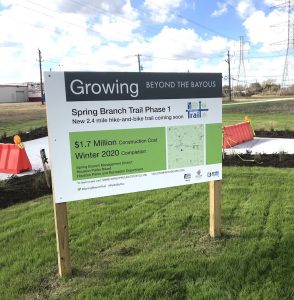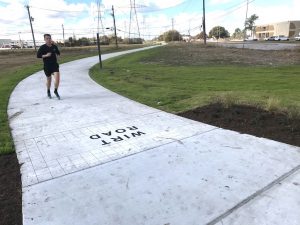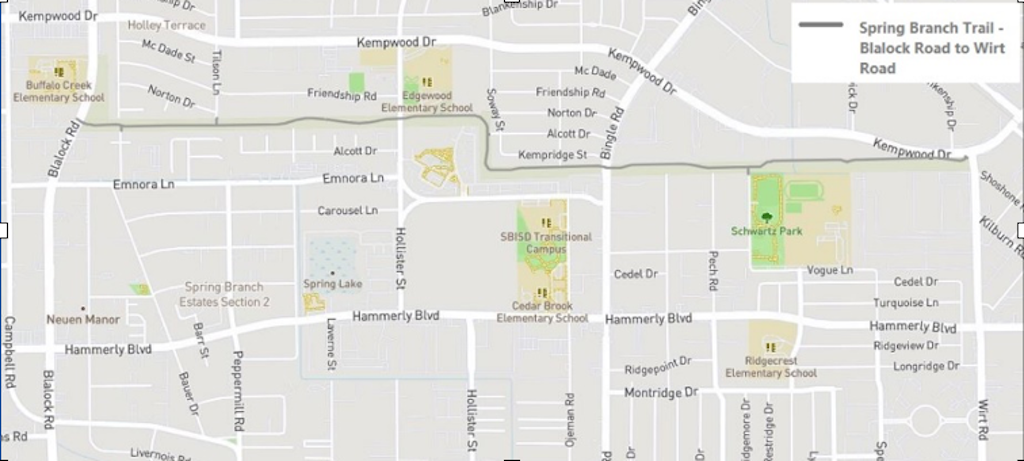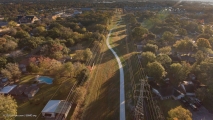Come and help Spring Branch celebrate the completion of a very special public project — on any day of your choosing. All you must bring is a bicycle or a pair of walking shoes!
Now open is Phase 1 of the Spring Branch Trail, a crucial segment in a planned trail network connecting the Addicks Reservoir trails on the west to the White Oak Bayou Greenway Trail on the east.
 The White Oak Trail already connects to trail leading to downtown Houston and, in the opposite direction, the suburbs north of Loop 610 North. So, the mammoth pathway will provide a 22-mile route for people-powered travel between the far western reservoirs to the heart of downtown.
The White Oak Trail already connects to trail leading to downtown Houston and, in the opposite direction, the suburbs north of Loop 610 North. So, the mammoth pathway will provide a 22-mile route for people-powered travel between the far western reservoirs to the heart of downtown.
And it won’t even stop there! Downtown trails along Buffalo Bayou Park connect easily to other paved trails running east toward the Port of Houston and southeast to the University of Houston, Texas Southern University and the Texas Medical Center.
It’s easy to think of Houston as a car-centric place, with our jumbo-width freeways and spaghetti-bowl interchanges. Now the new trail system will change people’s perceptions about the Bayou City’s local travel options. The trail network will bring more outdoor recreation, sightseeing and commuting options to the entire metropolitan area.
And it has all started in the heart of Spring Branch, thanks to funding of Phase 1 by the Spring Branch Management District. The District’s main partners in the project are the non-profit organization called the Houston Parks Board, and the Houston Department of Parks and Recreation.
The 10-feet-wide concrete trail stretches 2.4 miles between Blalock Road and Wirt Road, north of Hammerly Boulevard and south of Kempwood Drive, along open land on the CenterPoint Energy easement.
Brightly marked paths connect the trail to Schwartz Park, Buffalo Creek Elementary School, Edgewood Elementary School, St. Jerome Childhood Center, the Lion Lane School and Landrum Middle School. In addition to schools, the trail connects quiet neighborhoods, retail stores, places of employment and many of the other amenities that distinguish the dynamic District.
And with proper precautions by its users, the trail can be enjoyed safely during the pandemic.
 Construction companies started building the $1.7 million trail segment in May. But first, in early 2019, the District hosted public engagement meetings to hear feedback about the project from residents, business owners and other people. The dialogue was robust, providing hundreds of documented comments and suggestions.
Construction companies started building the $1.7 million trail segment in May. But first, in early 2019, the District hosted public engagement meetings to hear feedback about the project from residents, business owners and other people. The dialogue was robust, providing hundreds of documented comments and suggestions.
The project is also part of a broader vision published five years ago, called Reimagine Spring Branch: Spring Branch Management District Comprehensive Plan 2015-2030, based on input from the public, urban planners, architects, construction contractors, public agencies, District staff and more stakeholders. The plan provides the roadmap for the District to do what management districts do best: protect, preserve and enhance the assets of Spring Branch through programs involving pubic safety, economic development, infrastructure upgrades, recreational opportunities and more.
Phase 1 of the trail also tucks neatly into the Houston region’s plans to develop stronger transportation options besides the use of private motor vehicles. Houston can better control climate change effects, and the need for more and more highway construction, with alternative mobility networks — just one being the trail system that allows people to walk or pedal the entire way across town more safely.
With its dynamic growth diversity and opportunities, Spring Branch is now even more at the heart of Houston.

— By Alan Bernstein




























